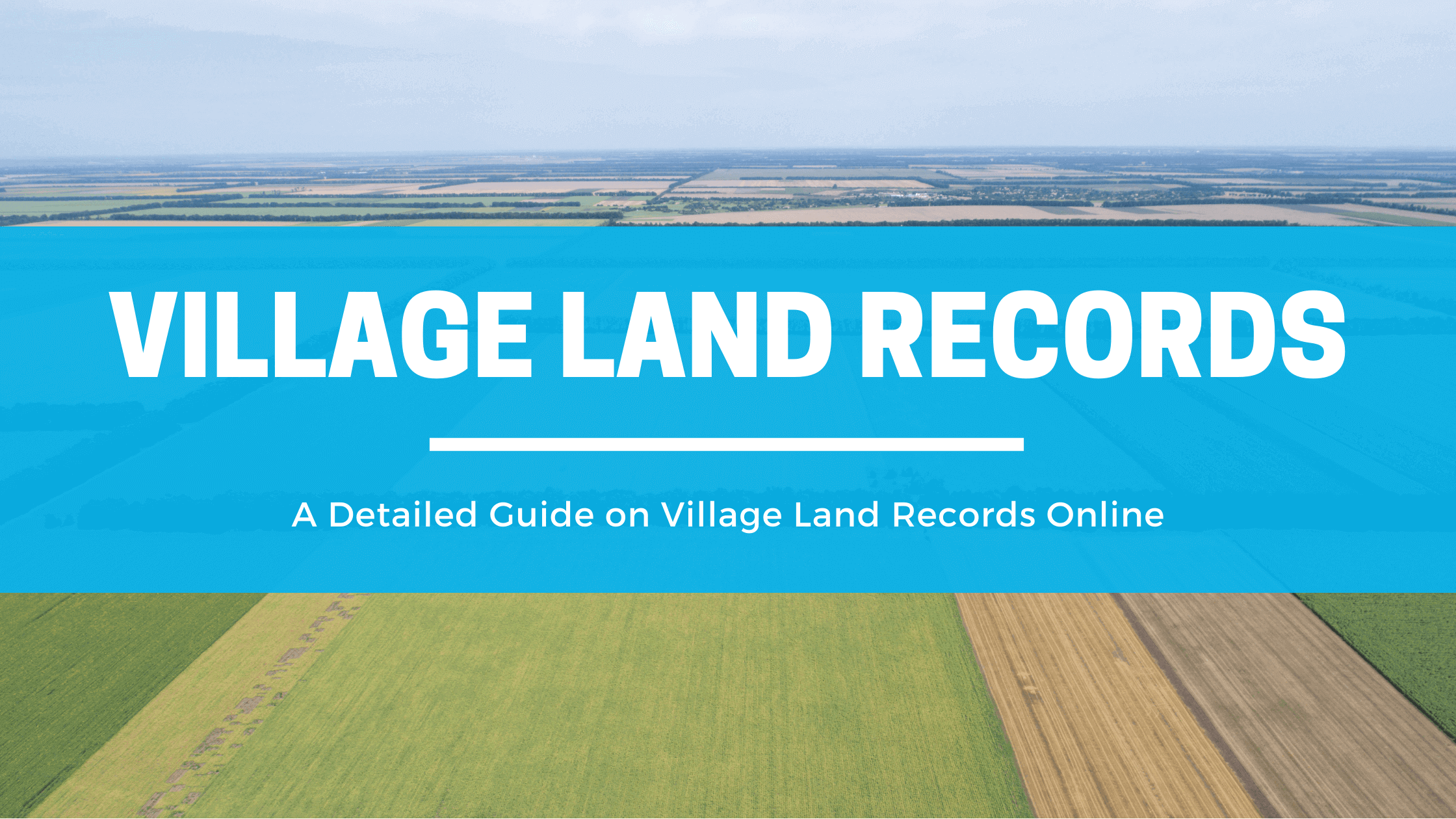With the poor management of land records, disputes, as well as ownership issues, have risen in India. As the use and accessibility of technology are increasing day by day, the reach of land records should also be available to every citizen. In the process of making it true, the Indian Government has digitized every part of the land including land records management along with the property registration process. Hence, the Government has given the property owners access to and verify the land and property records, which is just a click away from the user.
For anyone, it is very important to steer clear of fraud that might happen with them. In March 2018, the village land records of almost 192 villages out of 224 villages in Delhi were uploaded on digital platforms by the government. Details of the other land records Delhi villages will be digitized soon, according to the department of revenue. Once the issues that are hampering the village land records computerization of the remaining 32 villages are resolved, the details will be uploaded in no time. The availability of records of rights (RoR), which are digitally signed in the public domain 24*7, can also be downloaded by any citizen from anywhere.
Table of contents
What are Land Records?
Land Records is just a broader term that includes the registration of lands, tenancy and crop inspection register, Records of Rights (RoR), disputed cases register, mutation register, and many more land related services. Also, it has geological information related to the size, shape, and soil type of the recorded lands. It also includes the economic information related to crops and irrigation.
National Land Records Modernization Programme, a program to digitize the land related information, was launched by the Central Government. The program is now known as the Digital India Land Records Modernization Programme (DILRMP) in the month of August 2008. In this program, every detail about the land will be computerized or digitized including the digitization of maps, mutations, integration of the textual as well as spatial data, re-survey, survey. It also includes an update of all the settlements and survey records, which includes computerization of registration, creation of the cadastral original records wherever it is necessary, and the integration of the registration with the village land records maintenance system or land records maintenance system of other places in India. A further addition to it is the core development of Geospatial Information System (GIS) and the capacity for building.
Many state governments have digitized their land records, such as land records of Delhi can be checked through the online land records Delhi portal. The states who have digitized the land and property records are Rajasthan, Haryana, Uttarakhand, Karnataka, Chhattisgarh, Himachal Pradesh, Odisha, Madhya Pradesh, Uttar Pradesh, West Bengal, and Kerala. The Delhi government has also been digitizing its land records. The land records are also known as Bhulekh, Khasra, or Khata details. Under the DILRMP project, the online land records Delhi, the information of about 1,80,000 Khasra and 78,000 properties have been digitized for the citizens.
Steps to Check Village Land Records Online
The online land records check process is simpler and the information can be accessed by the citizens from anywhere. For example, the details of villages in Delhi are given. Salem Pur Majra Burari, Burari, North East Delhi, New Delhi.
With the steps mentioned below, you can easily go for the online checking of land records.
Step 1: Visit the official portal of the Land Records of the state you are searching for. Here we will visit the official portal of Land Records Delhi - dlrc.delhigovt.nic.in.
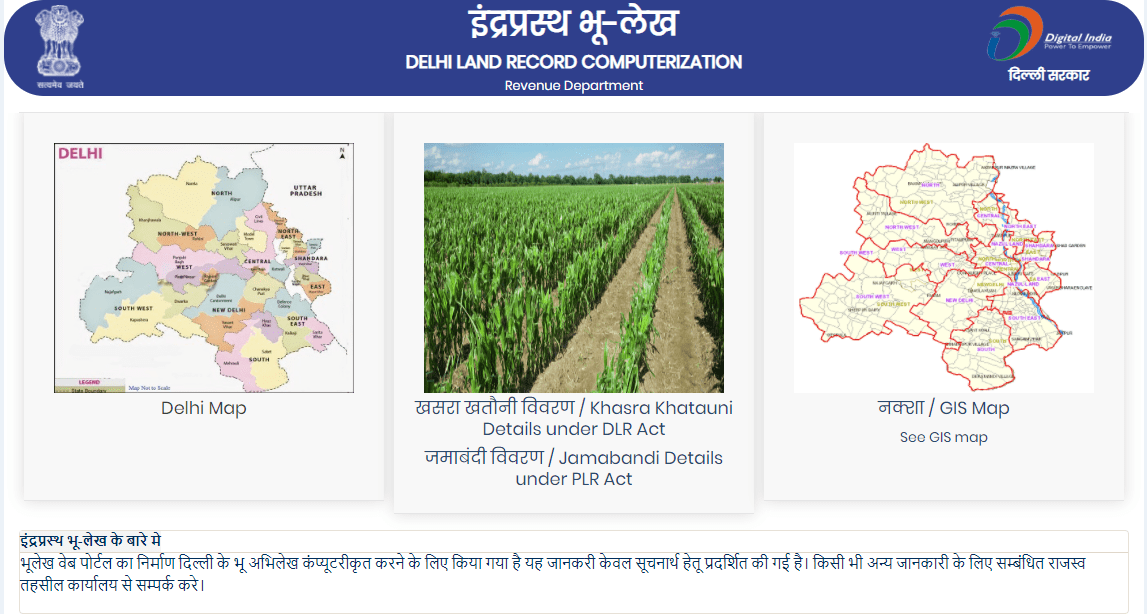
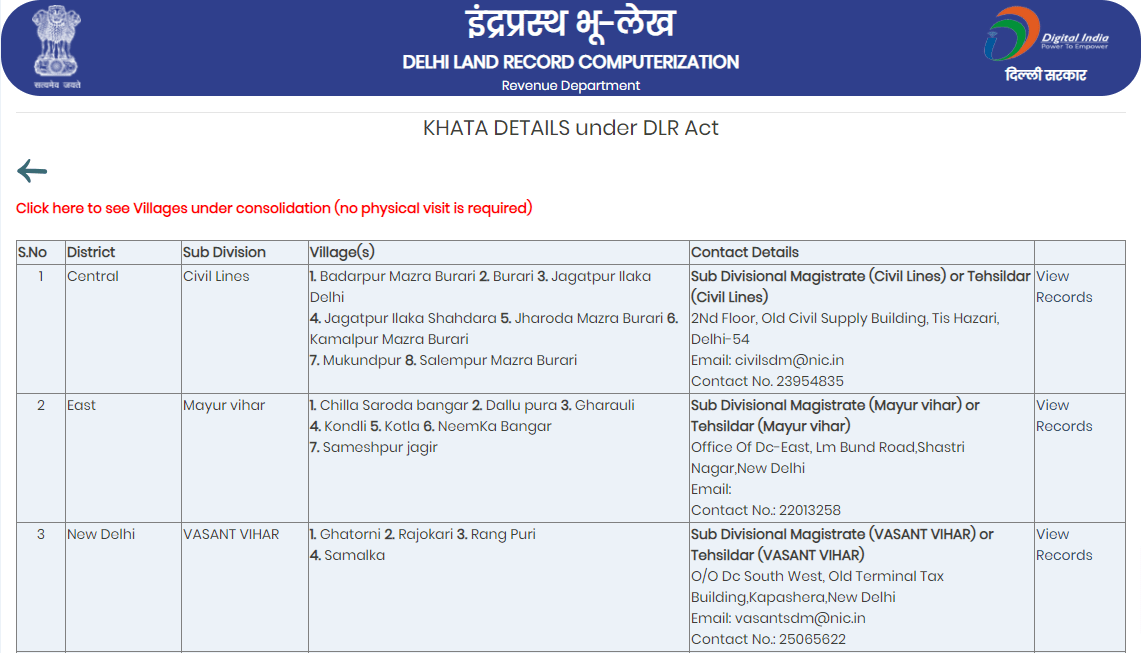
Step 2: Then select the district along with sub-division to find the village land records information, where it is situated. At present, the land is a village in north east Delhi, which is located in the Burari area.

Step 3: Now, select the Tehsil or the name of the village. In this situation, the name of the village is Salem Pur Majra Burari. Then, select the type of Khata. In most cases, the land owners in the village land records mentioned are Bhumidars. The category of land owners is known as Bhumidars as it consists of the land owners who either have heritable, permanent, or transferable rights to their land holdings. Asami is the category given to the tenants or the sub tenants who held Gaon Samaj lands. The rights of Asami are heritable but are non permanent as well as non transferable.
Step 4: With the help of a khasra number or the name of the owner, you can easily get the details of the land. For example, let's select Khata number 13 in Salem Pur village of north east Delhi.
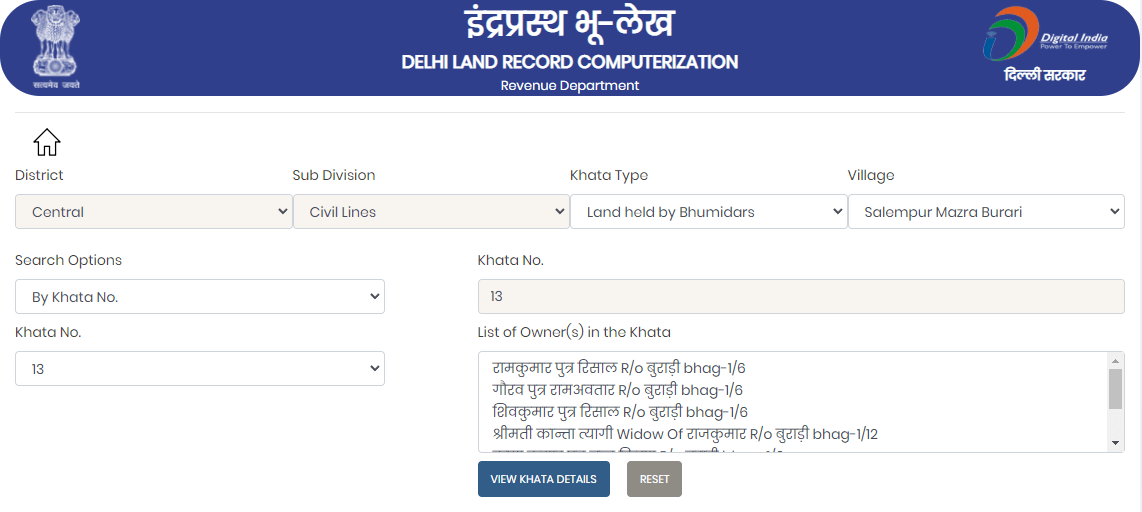
Step 5: Now, click on the option to view Khata details to find the required information. The information will also include the portion of land each owner owns, the area of land, and the khasra number. Information or remarks that are pertaining to any kind of loan related to land or the property is being leased out, then such information will also be available in the village land records under a separate section. At present, the records talk about gift deeds which are basically a document that signifies the voluntary transfer of the property without the involvement or exchange of money.
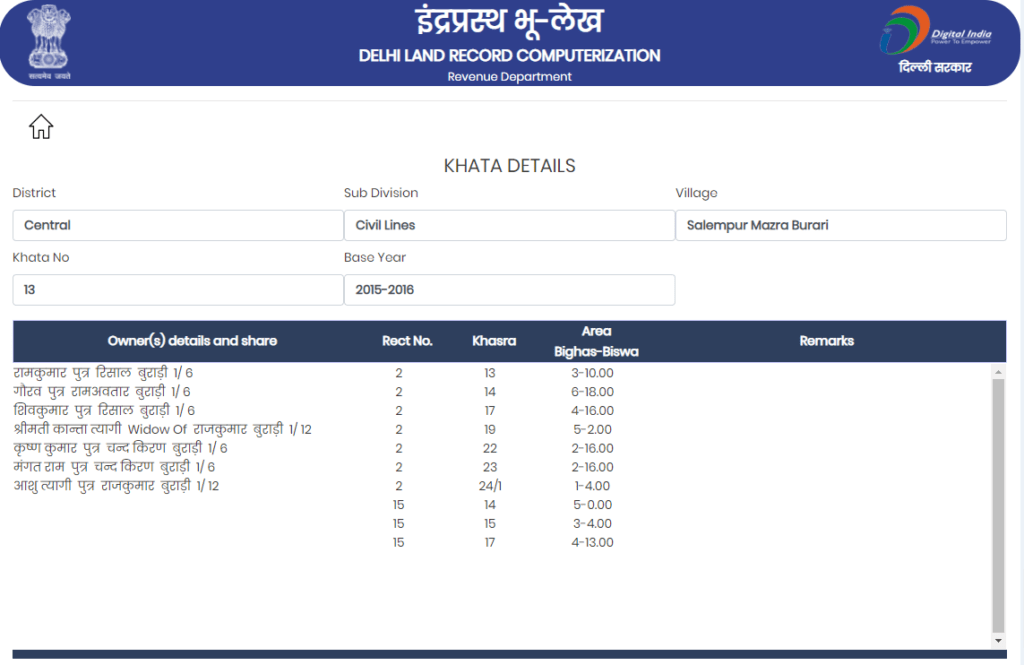
In this way, you can proceed and view the Khatauni details on the village land records website of the states who have digitized their land records.
Benefits of Digitizing Land Records
- Easy to access the land records: By digitizing the land records, visiting the revenue office to view the information is not needed anymore. Now, with the help of online databases, it enables the citizens to check land records online along with their legal status with ease. The citizens can also cross-check the land status with the help of maps that are put up to show the grounding situation. The citizen can also raise the issues in any case of discrepancies.
- Better Transparency: With the land records online check, the system aims to implement a long lasting system that ensures a guarantee to the citizens for protecting the land records and makes it tamper-proof. Hence, this will help in avoiding litigation and disputes. The other objective of this new system is to provide accurate land information under the single window of land records to the citizens. It will also assure the citizens of data integrity. Frauds and encumbrances while issuing the copies will also be taken under check by the government and authority.
- Easy to Maintain: With digitization, the chances of grievances caused because of delays will be eliminated. At the same time, it will ensure smooth maintenance along with the updates of land record databases on time.
Importance of Land Records for Farmers in Village
There are a number of reasons for which village land records are important for the farmers in the village. For instance, if a farmer in a village wants to buy a land or plot, they will first need to authenticate the property. And the authentication of land in villages is only possible through village land records. If the farmer wants to take out a loan from the bank to dig up a hole in his land, then he will be asked to show the land records in order to get the loan approval from the bank. Moreover, these land records are essential not only for farmers but for everyone for the selling and buying of lands. At last, even for dividing the properties among his children, he will need to have a land record.
Few Points to Remember
Below are the various details mentioned under the online land records:
- Name of the present owner.
- The registered address of the present owner.
- Use pattern of the land that specifies if the land is agricultural, passage, waste land, owned by the government, residential, commercial plot, or village land.
- Land parcel measurements (areas of lands in Bighas).
- Any of the land use conversions in the past.
- Loan released on or against the land or applicable mortgage.
- Transactions related to that land or transfers of land.
- Any government orders issued with respect to that land.
On a periodical basis, the online land records are updated by the authority. The Tehsil Office attests to the documents, otherwise, the documents can not be served as valid proof and produced in the court as evidence. To obtain the authorized copies, one can visit the concerned Tehsil Office or Revenue Department by submitting an official application form and paying a nominal fee for the application and copies.
Explore Land Records of Other States in India
| Karnataka | Bhoomi Online RTC |
| Chhattisgarh | CG Bhuiya |
| Uttarakhand | Bhulekh UK |
| Punjab | PLRS |
| Madhya Pradesh | Bhulekh MP |
| West Bengal | Banglarbhumi |
| Odisha | Bhulekh Odisha |
| Bihar | Land Record Bihar |
| Jharkhand | Jharbhoomi |
| Tamilnadu | Patta Chitta |
| Maharashtra | Mahabhulekh |
| Telangana | Dharani |
| Andhra Pradesh | Mee Bhoomi |
| Gujarat | AnyROR |
Frequently Asked Questions (FAQs) About Village Land Records
How do I find out the land details of a village using RTI?
To find out the land details of a village, using RTI, one can file an RTI application to the concerned Gram Panchayat Officer and submit the nominal fee. Then, carbon copy the same RTI application to the PIO, Mandal/District Office as well.
How to check land records online in India?
To find and check land records online in India simply, visit the land records official website of the state in which the property is located. Then register on the website, and to find the information, fill in the details asked by the portal, such as division, sub-division, khata, khasar, name of the owner, etc.
What are the duties of a Lekhpal?
Lekhpal is in the clerical government post, who is responsible for maintaining the revenue account of the village, and at the same time, he is also responsible for maintaining the village land records.
Who keeps the land records in a village?
Patwari, who is an Administrative Officer in the village or the village account is responsible for keeping, updating as well as maintaining the village land records.
Who collects land revenue in a village?
Patwari, Tehsildar, Karmchari, Land Record Officer, or Kanungo is the person who is responsible for collecting land revenue in a village. They are known by different names in different parts of the country.
What is Naib Tehsildar?
The immediate subordinate of a Tehsildar is the Naib Tehsildar. It is kind of akin to a deputy commissioner. They are basically the revenue inspectors who accompany the tax officers. They are responsible for obtaining the taxes from a tehsil which is in regard to the land revenue.

